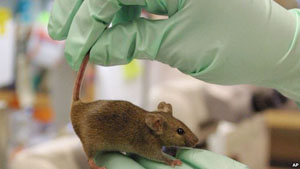From VOA Learning English, this is the Health Report.
Could young blood be the answer to cheating death? It may sound like thestory in a vampire movie but now there is scientific research that supports thetheory.
 |
|
A protein found in young mice, which is also found in humans, formed new blood vessels and improved blood flow in older mice. |
U.S. scientists have discovered a protein in the blood in young mice that canundo some effects of aging in old mice. The same protein is present inhuman blood and might one day help us lead healthier lives.
Two papers published in the journal Science discuss this protein, calledGDF11.
Researchers at Harvard University in Cambridge, Massachusetts explain howGDF11 improved the brain and muscle ability of older mice. This protein isfound in high levels in the blood of young mice. And it appears to help developnew blood vessels.
In one experiment, the scientists increased the levels of GDF11 in aging miceby surgically connecting (or infusing) the blood flow systems of young mice to the old mice. Blood containing higher levels of GDF11 flowed among bothgroups. In another experiment, they injected the protein into old mice.
Scientists saw the greatest change in the old mice that shared blood flow withthe young.
The old mice formed new blood vessels. The animals’ blood flow improved. And the aging process changed directions, or reversed, in every tissue theresearchers observed.
Researcher Lee Rubin is a professor of stem cellresearch at Harvard's Stem Cell Institute. His teamlooked at the effect of GDF11 on brain tissue.
"So, this simple surgery, infusing an old mouse withyoung blood, actually produced some structuralchanges in the old brain, making the old brain, inessence, more like (a) young brain. And some peoplehave used the phrase 'rejuvenating the old brain.' Andsimilar things were observed in other tissues."
Rubin's teammate Amy Wagers said that GDF11 repaired DNA damagelinked to aging. Wagers said earlier GDF11 research showed a change in theweakened hearts of older mice. The hearts returned to a more youthful sizeand beat more efficiently.
So, this is great news for old mice. But what does it mean for us? There isgrowing hope GDF11 might someday repair and renew unhealthy humanhearts. Also, Mr. Rubin says the protein might improve memory power forAlzheimer's patients or physical movement for people with Parkinson'sdisease.
But the researcher says the protein is not a "fountain of youth." He says theaim of the research is not to lengthen life as much as to improve it.
"In other words, even if you did not live more years, at least you could remainhealthier for the number of years you do live. And I think again, what we'veshown is functional improvement in ... various different tissues in mice."
Researchers at Stanford University in California are doing similar research. They report that blood from young mice improved brain operations in oldermice.
Researchers in Massachusetts and California are working with technologycompanies that specialize in human medicine to see how these findings canhelp humans.
Harvard University's Lee Rubin predicts human testing could begin in as littleas three years.
And that’s the Health Report. I’m Anna Matteo.







